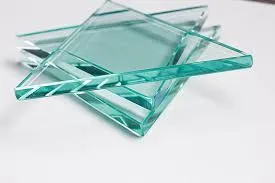The Float Glass Process An Overview
The float glass process is a pioneering method for producing high-quality flat glass, widely utilized in the construction, automotive, and various glassware industries. Invented in the 1950s by Sir Alastair Pilkington in the UK, this innovative technique revolutionized glass manufacturing, leading to the production of perfectly flat, smooth, and uniform glass sheets. Today, the float glass process is recognized as the standard method for glass manufacturing worldwide.
At the heart of the float glass process is the use of molten glass, which is created by melting a mixture of silica sand, soda ash, and limestone at approximately 1,600 degrees Celsius. This molten glass is then poured onto a bed of molten tin. The tin serves a dual purpose first, it provides a highly flat surface for the glass to float on, and second, it is non-reactive with glass, preventing any contamination that could adversely affect the glass's quality. This floating technique results in glass sheets that have an excellent surface quality with minimal distortion.
One of the key advantages of the float glass process is that it produces glass with superior optical clarity. The even thickness and absence of imperfections allow for better light transmission, making it ideal for applications such as windows and glass facades. Moreover, the process yields large sheets of glass, often measuring up to 3.2 meters wide and several meters long, which reduces the need for seams and seams—a critical advantage for large architectural projects.
float glass process
Once the glass has cooled and solidified on the tin bath, it proceeds to an annealing lehr, where it undergoes a controlled cooling process. This step is crucial as it relieves internal stresses caused during the forming process, resulting in a product that is less prone to breakage. The glass is then cut into desired sizes and can be further processed into various products, including tempered or laminated glass, depending on specific requirements.
The environmental impact of the float glass process has also been a point of discussion. The method is energy-intensive, largely due to the high temperatures required for melting the raw materials. However, advancements in technology have led to more energy-efficient furnaces and improved recycling processes, allowing manufacturers to reuse cullet (broken glass) to reduce energy consumption and raw material use. The industry is continuously working towards reducing its carbon footprint, incorporating sustainable practices, and finding alternative materials.
Furthermore, the float glass process is versatile, allowing for the production of various types of glass, such as low-emissivity (low-E) glass, which is designed to reflect infrared light while allowing visible light to pass through. This type of glass enhances energy efficiency in buildings by minimizing heat loss, making float glass suitable for modern, energy-efficient architecture.
In conclusion, the float glass process has fundamentally transformed the glass manufacturing industry, offering a method to produce superior-quality flat glass with unmatched clarity and uniformity. Its ability to meet the varying demands of multiple industries, coupled with ongoing advancements in sustainability, ensures that the float glass process will continue to play a vital role in our built environment for years to come. As technology progresses, we can expect further innovations within this process, leading to even better products and practices in glass production.
 Afrikaans
Afrikaans  Albanian
Albanian  Amharic
Amharic  Arabic
Arabic  Armenian
Armenian  Azerbaijani
Azerbaijani  Basque
Basque  Belarusian
Belarusian  Bengali
Bengali  Bosnian
Bosnian  Bulgarian
Bulgarian  Catalan
Catalan  Cebuano
Cebuano  Corsican
Corsican  Croatian
Croatian  Czech
Czech  Danish
Danish  Dutch
Dutch  English
English  Esperanto
Esperanto  Estonian
Estonian  Finnish
Finnish  French
French  Frisian
Frisian  Galician
Galician  Georgian
Georgian  German
German  Greek
Greek  Gujarati
Gujarati  Haitian Creole
Haitian Creole  hausa
hausa  hawaiian
hawaiian  Hebrew
Hebrew  Hindi
Hindi  Miao
Miao  Hungarian
Hungarian  Icelandic
Icelandic  igbo
igbo  Indonesian
Indonesian  irish
irish  Italian
Italian  Japanese
Japanese  Javanese
Javanese  Kannada
Kannada  kazakh
kazakh  Khmer
Khmer  Rwandese
Rwandese  Korean
Korean  Kurdish
Kurdish  Kyrgyz
Kyrgyz  Lao
Lao  Latin
Latin  Latvian
Latvian  Lithuanian
Lithuanian  Luxembourgish
Luxembourgish  Macedonian
Macedonian  Malgashi
Malgashi  Malay
Malay  Malayalam
Malayalam  Maltese
Maltese  Maori
Maori  Marathi
Marathi  Mongolian
Mongolian  Myanmar
Myanmar  Nepali
Nepali  Norwegian
Norwegian  Norwegian
Norwegian  Occitan
Occitan  Pashto
Pashto  Persian
Persian  Polish
Polish  Portuguese
Portuguese  Punjabi
Punjabi  Romanian
Romanian  Russian
Russian  Samoan
Samoan  Scottish Gaelic
Scottish Gaelic  Serbian
Serbian  Sesotho
Sesotho  Shona
Shona  Sindhi
Sindhi  Sinhala
Sinhala  Slovak
Slovak  Slovenian
Slovenian  Somali
Somali  Spanish
Spanish  Sundanese
Sundanese  Swahili
Swahili  Swedish
Swedish  Tagalog
Tagalog  Tajik
Tajik  Tamil
Tamil  Tatar
Tatar  Telugu
Telugu  Thai
Thai  Turkish
Turkish  Turkmen
Turkmen  Ukrainian
Ukrainian  Urdu
Urdu  Uighur
Uighur  Uzbek
Uzbek  Vietnamese
Vietnamese  Welsh
Welsh  Bantu
Bantu  Yiddish
Yiddish  Yoruba
Yoruba  Zulu
Zulu 

